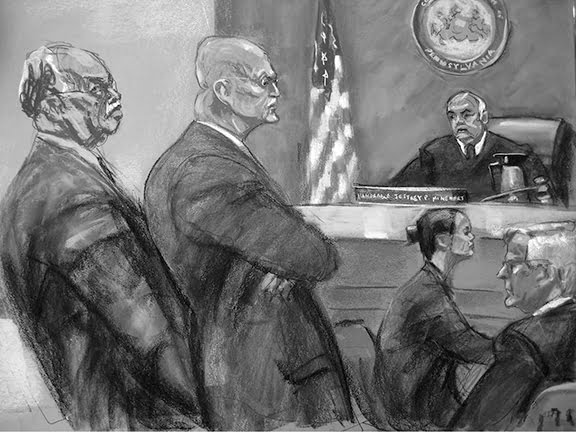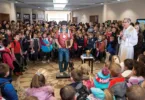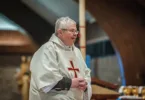
This sketch depicts the court proceedings of abortionist Dr. Kermit Gosnell’s trial. Gosnell (far left) was convicted on over 243 counts, including first-degree murder, infanticide, involuntary manslaughter, and performing illegal late-term abortions.
Abortionist’s conviction raises issue of fetal pain to national stage.
by Joe Bollig
joe.bollig@theleaven.org
KANSAS CITY, Kan. — Weeks of demonstrations, disruptions and a 10-hour filibuster by a pro-abortion senator couldn’t stop a Texas Senate committee from passing a new pro-life bill on July 11.
The battle of the bill became high-profile news reported by major news mediums.
The bill requires abortion clinics to meet the same health and safety standards as do other surgical centers in Texas and bans aborting fetuses after 20 weeks of pregnancy.
Pro-abortion legislators and their supporters opposed the bill ferociously.
To protest the bill, they hung coat hangers on a podium to warn that crude, dangerous and illegal abortions would be a consequence of the bill, and denounced the bill as part of a “war on women.”
The irony was lost on the pro-abortion activists that a major inspiration of the legislation was a Philadelphia abortionist who did crude, dangerous and illegal abortions and who was responsible for the deaths of at least two patients.
It wasn’t only Texas that saw legislation inspired by the case of the gruesome Philadelphia abortionist, but also Ohio, North Carolina and Wisconsin.
Kansas passed a law in 2011 banning abortions after 20 weeks of pregnancy and this year passed another law that required doctors to tell women that unborn children can feel pain by 20 weeks.
In June, the Judiciary Committee in the U.S. House of Representatives passed a fetal pain law banning abortions after 20 weeks, but it is expected to fail in the U.S. Senate and President Barack Obama has vowed to veto the bill.
So far, nine states have passed fetal pain capable laws, and Texas could be the tenth.
Shattered myth
If ever there was a watershed moment in the history of abortion in America, it would be Feb. 18, 2010.
That was the day the myth of “safe and legal abortion” in America was shattered in a matter of minutes.
On that date, agents of the Federal Bureau of Investigation and state law enforcement agencies entered the Women’s Medical Society in Philadelphia, where Dr. Kermit Gosnell performed abortions.
They were investigating tips about illegal prescription drug use, but within moments it became clear that other things were very, very wrong at the clinic besides illegal drug activity.
In a later grand jury report, Philadelphia district attorney R. Seth Williams described discoveries in the clinic that has become known as the Philadelphia House of Horrors:
“The clinic reeked of animal urine, courtesy of the cats that were allowed to roam (and defecate) freely. Furniture and blankets were stained with blood. Instruments were not properly sterilized. Disposable medical supplies were not disposed of; they were reused over and over again. Medical equipment — such as the defibrillator, the EKG, the pulse oximeter, the blood pressure cuff — was generally broken; even when it worked, it wasn’t used. The emergency exit was padlocked shut. And scattered throughout, in cabinets, in the basement, in a freezer, in jars and bags and plastic bags, were fetal remains. It was a baby charnel house.”
But that wasn’t the worst of it.
Further investigation revealed that Gosnell endangered women by overdosing them with dangerous drugs, spreading disease with infected instruments, causing injury (perforated bowls and wombs) and even caused the death of two women.
And then something truly horrifying was discovered.
Gosnell had regularly performed illegal, late-term abortions of viable babies. Pennsylvania law prohibits abortions after the 24th week — a time when babies, if they are born premature, can survive.
When some babies survived Gosnell’s abortions “live, breathing, [and] squirming,” Gosnell killed them by jabbing scissors into the back of the babies’ necks, and snipping their spinal cords. He called it “snipping.”
Gosnell performed hundreds of “snippings” over the years, but the exact number is unknown because he destroyed his files.
A few cases, however, could be documented. Gosnell, his wife, and eight clinic workers faced murder and other charges.
Gosnell himself was convicted this past May 13 of three counts of first-degree murder of three babies, involuntary manslaughter of a patient, one count of infanticide, 21 counts of performing illegal late-term abortions, and many other crimes — a total of 243 convictions.
He made a deal with prosecutors, waiving his right to appeal so he would not face the death penalty. In exchange, he got life in prison without parole.
A look behind the curtain
The Gosnell case tore down the curtain that hid some brutal realities of abortion in America, said Carol Tobias, president of the National Right to Life Committee.
“For [Americans] to hear stories about this man who delivered babies shortly before birth and snipped their necks was horrifying, because they didn’t know something like this was going on,” said Tobias.
Despite the gruesome nature of the charges, the Gosnell trial received scant attention from national news mediums until pro-life activists launched a social media shaming campaign that included rows of empty seats in the press gallery.
“I think there was a definite attempt to ignore the story,” said Tobias.
By contrast, the major news outlets were all over the trials of George Zimmerman, Casey Anthony, Jody Arias and others, she said.
“But we are seeing now, because the U.S. Congress took up the Pain Capable Unborn Child Protection Act and other states like Texas working on it, it has gotten more attention,” she continued. “Even if people didn’t hear about Gosnell [then], they are now, because [he] is one of the reasons we need to pass this legislation.”
Although pro-abortion advocates claim that legalization took abortion out of unsafe “back alleys” and into safe clinics, the Gosnell case proves otherwise, said Tobias.
“Making abortion legal through [the 1973 U.S. Supreme Court case] Roe v. Wade did not make abortion safer,” she said.
Besides, abortion always kills the baby and, in many cases, causes physical and psychological harm to women, no matter how sterile or well-run the clinic.
The Gosnell trial led several states to undertake long-overdue clinic inspections, which led to the discovery of many shortcomings and problems. For example, the Maryland state health department found unsanitary conditions and deficiencies in 12 of the state’s 16 surgical abortion clinics.
“There is an abortionist in Texas who is reported to have killed babies by inducing birth and then twisting their heads off,” Tobias said.
Eventually, Gosnell himself will fade into obscurity and become a footnote. The ripple effects, however, will continue, said Ron Kelsey, archdiocesan consultant for pro-life ministry.
“The Gosnell case has raised the discussion of late-term abortion and fetal pain to the national level,” he said. “It has given us an opportunity to see late-term abortion — and we don’t like it. Most people, once they understand, are opposed to late-term abortions.”
“This case has laid the groundwork for future legislative efforts,” he continued. “It has created an awareness in the public mind. We may have to wait until elections restructure the U.S. House and Senate to pass pro-life legislation, and we have a president willing to sign it, but the pro-life movement is working toward it.”






